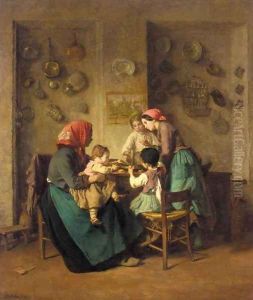Charles-Edouard Frère Paintings
Charles-Édouard Frère was born on November 21, 1837, in Paris, France, into a family with a rich artistic heritage. His father, Pierre Edouard Frère, was a notable genre painter, which influenced Charles-Édouard to pursue a similar path in the arts. He was trained by his father and was exposed to the art world from a very young age. His family's environment was conducive to his development as an artist, as he was surrounded by the works and influence of other contemporary artists.
Charles-Édouard Frère specialized in genre scenes and landscapes, often depicting rural French life in a sentimental and idealized manner. His works typically reflected the daily activities of peasants and rural folk, with a focus on children, which was a theme also favored by his father. He exhibited his paintings at the Paris Salon, the official art exhibition of the Académie des Beaux-Arts in Paris. His first exhibition at the Salon was in 1859, and he continued to display his work there throughout his career.
Frère's style was influenced by the Barbizon school, a group of painters that focused on realism and nature, as well as the 17th-century Dutch genre painters. He was known for his skillful use of light and delicate brushwork, which brought warmth and charm to his scenes. Although he did not achieve the same level of fame as some of his contemporaries, his works were well-received and collected in his time, particularly by English and American patrons.
Throughout his career, Charles-Édouard Frère often collaborated with other artists, including his brother, Henri Frère, who was also a painter. He remained active as an artist until his death on May 24, 1894, in Ecouen, a village north of Paris that was a popular residence for artists. Today, his works can be found in various art museums and private collections, and he is remembered for his contributions to genre painting and his depictions of 19th-century French rural life.
